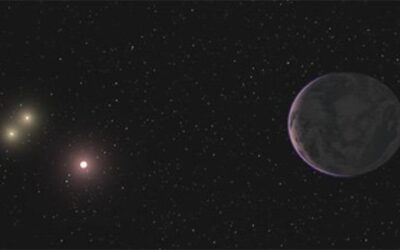Si ya una vez hablamos de un planeta que orbitaba alrededor de dos estrellas (ver http://andres96cmc.blogspot.com.es/2016/06/nuevo-exoplaneta-con-dos-soles-new.html), ahora, científicos del Observatorio Europeo Austral, en Chile, (ESO, por sus siglas en inglés) han descubierto con el Very Large Telescope (VLT) un exoplaneta peculiar: tiene nada más y nada menos que tres soles. El planeta ha sido bautizado como HD 131399Ab.
El planeta ha sido descubierto por observación directa, un hecho bastante exitoso, debido a la dificultad del método de búsqueda. Buscar un exoplaneta a varios años luz de la Tierra con un telescopio es como buscar una aguja en un pajar. Es un planeta muy joven, es más, es un bebé, solo tiene 16 millones de años de antigüedad, es muy poco comparado con los casi 4500 millones de años de la Tierra. Cuando este planeta nació, los primeros primates empezaron a desarrollarse en la Tierra, con lo que así podemos dar muestra de que es un planeta bastante joven. Al ser tan joven, se descarta la posibilidad de que este planeta pudiese albergar vida.
Tarda 550 años terrestres en completar una órbita alrededor de la estrella más brillante de las tres, siendo uno de los planetas que más tardan en girar alrededor de su estrella de todos los sistemas planetarios con más de una estrella. Es cuatro veces más masivo que Júpiter y se alcanzan casi los 600 ºC en su superficie. Todos estos datos han sido obtenidos gracias al análisis de su espectro, al ser observado directamente. Su estrella más brillante es un 80% más masiva que el Sol.
Los expertos afirman que no es tan raro encontrar planetas orbitando en torno a varias estrellas a la vez. El mes pasado ya se encontró un planeta con dos soles, en la entrada mencionada arriba del todo, y se cree que puede haber planetas que estén orbitando incluso alrededor de cinco estrellas.
If we once talked about a planet orbiting two stars (see http://andres96cmc.blogspot.com.es/2016/06/nuevo-exoplaneta-con-dos-soles-new.html), now, scientists from the European Southern Observatory (ESO), in Chile, have discovered with the Very Large Telescope (VLT) a special exoplanet: it has three suns. It has been named as HD 131399Ab.
The planet has been discovered by direct observation, a pretty successful fact, due to the difficulty of the method of search. Looking for an exoplanet some light years away from Earth only with a telescope is like looking for a needle in a haystack. It is a pretty young planet, in fact it is a newborn, being only 16 million years old; it is very short time in comparison to the age of the Earth, which is almost 4.5 billion years old. When this planet was born, the first primates started to develop in Earth, that shows it is a really young planet. As it is so young, the possibility of existing life in there is discarded.
It spends 550 years in completing an orbit around the brightest star out of the three of them, being one of the planets orbiting more than one star taking longer to orbit them. It is four times more massive than Jupiter and temperatures close to 600 ºC can be reached in its surface. All these data have been obtained thanks to the analysis of its spectrum when being directly observed. The brightest star is an 80% more massive than the Sun.
Experts state that it is not so strange to find planets orbiting around more than one star. Last month a planet orbiting two stars was found, being commented in the entry mentioned before and it is thought that there could be planets orbiting as much as five stars at the same time.
Para más información / For more information: http://www.elmundo.es/ciencia/2016/07/07/577e9669ca4741aa2e8b45c8.html

No hay comentarios:
Publicar un comentario